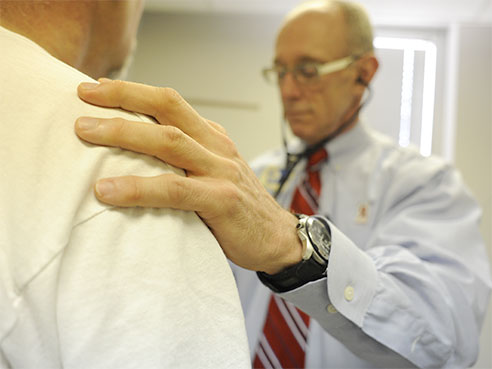 The University of Alabama at Birmingham and Birmingham AIDS Outreach have implemented a joint research project to locate, assess and re-engage people living with HIV/AIDS who have fallen out of primary care.
The University of Alabama at Birmingham and Birmingham AIDS Outreach have implemented a joint research project to locate, assess and re-engage people living with HIV/AIDS who have fallen out of primary care.
About 50 percent of persons diagnosed with HIV receive regular HIV care, according to the Centers for Disease Control and Prevention. The CDC also says about 28 percent of all persons with HIV in the United States have suppressed viral loads, meaning about 1.2 million new HIV infections can be expected to occur in the United States over the next 20 years, unless these patients get and stay in treatment.
Birmingham Access to Care, which launched in 2013, seeks out past patients of the 1917 Clinic who are considered “out of care” either due to missed appointments or because it has been too long since they last saw the doctor.
“We hope to re-engage a significant portion of the out-of-care population of people living with HIV/AIDS,” said Jeremiah Rastegar, program manager in the Division of Infectious Diseases and BA2C project director. “Coming to the clinic regularly is most important to keeping HIV viral load, or the amount of HIV in the blood, suppressed.”
Rastegar says they also hope to see whether anti-retroviral treatment and access to services, an intensive strengths-based case management/motivational interviewing model used to link and retain new patients in care, can also be useful in helping people return to care.
“Anti-retroviral therapy is effective at reducing viral load among PLWHA but needs to be monitored regularly to ensure proper dosage and effectiveness,” Rastegar said.
According to Rastegar, patients with suppressed viral loads:
- have higher quality of life
- have better overall health
- are much less likely to transmit HIV to others
| “We hope to re-engage a significant portion of the out-of-care population of people living with HIV/AIDS. Coming to the clinic regularly is most important to keeping HIV viral load, or the amount of HIV in the blood, suppressed.” |
“To overcome this obstacle, we have just begun using a variety of new recruitment methods, including the use of social media and Craigslist as recruitment avenues for the study,” Rastegar said.
Once interested patients have been reached, they will come to an enrollment session and complete a survey that asks about barriers to care, their current mental and physical health, self-efficacy, and stigma. The patient will then be assigned to a usual care or intervention group. If the patient is assigned to usual care, he or she is offered information about BAO and the 1917 Clinic and is encouraged to return to care. If the patient is assigned to intervention, he or she is introduced immediately to a community social worker who will have the goal of getting the patient back into care by finding ways to overcome barriers to care like lack of transportation or stable housing, or mental illness. The patients are followed for 18 months to see how they are doing, with the survey being repeated every six months.
Success of the project is twofold, Rastegar says.
“If we can get people to stay in HIV care, it means better health outcomes for both patients and the community,” he said.
This project will continue recruiting patients into early 2015.